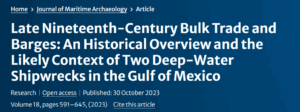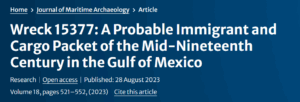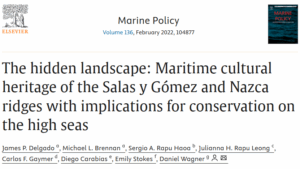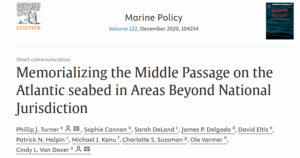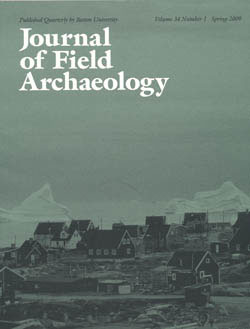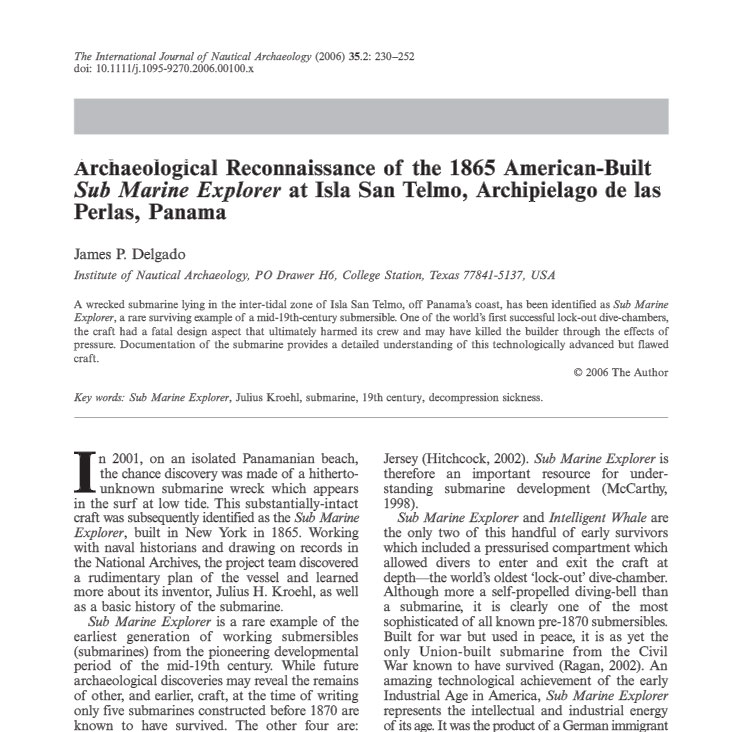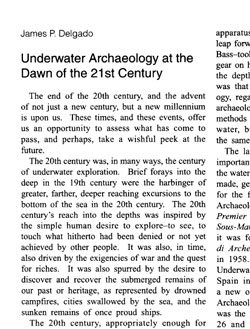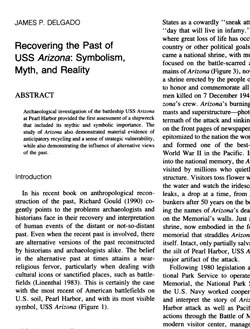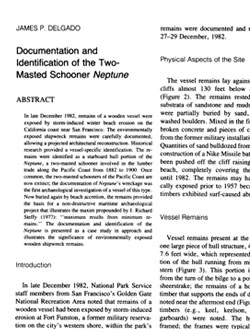Jim has written numerous articles for a variety of scientific journals. As part of a maritime archaeologist’s commitment to their career, publishing their work for other scholars to learn from is a very important step in the record-keeping process and helps keep the history books up-to-date.
Here are selected pieces.
Ocean News & Technology
Deep-Sea Discoveries Connect Global Audiences
Ocean News & Technology, June 2025, pp. 20-21.
In 2023 and again in 2025, I was privileged to serve as a chief scientist ashore for two separate mission to the deep offshore waters of Papahānaumokuākea Marine National Monument. In addition to its federally protected status, the waters and seabed are also a UNESCO World Heritage Site. It is sacred to Native Hawaiians as the realm of Kanaloa, a great god whose realm is the deep ocean.
International Journal of Maritime Archaeology
SS Albatross: An unfortunate steamship
International Journal of Maritime Archaeology, June 2025
Abstract excerpt: The short career of the Philadelphia-built coastal steamship Albatross (1850–1853) offers an instructive look at speculation, financing and operating a steamer in the mid-nineteenth-century United States. This was a period of rapid change, financial booms and busts, and business failures. Albatross was built for a short-lived route between Philadelphia and Charleston, South Carolina, which failed. With a change in ownership and a new home port of New York, it did not last long in its next venture, connecting New York with Halifax, Charlottetown and Quebec. Its final service in a speculative steamship line that proposed to open a competitive route across Mexico’s ‘Isthmus of Tehuantepec’ ended in disaster.
Journal of Maritime Archaeology
Blake Plateau: Cultural Connections and the National Significance of an Offshore Maritime Cultural Landscape
Journal of Maritime Archaeology, November 2024
Abstract: The Blake Plateau and the adjacent waters and sea beds of the U.S. continental shelf and Blake Ridge are a long-standing water highway, a place of significant events and common marine activities from centuries past to the present. It has scientific significance as well as cultural meaning, especially within the context of the Gullah/Geechee people of the region whose ancestors were brought against their will in the Middle Passage voyages of the transatlantic slave trade. The known location of some deep water shipwrecks, it is the likely site of many others, as well as possessing significant cultural values that make it worthy of consideration as a marine protected area.
Journal of Maritime Archaeology
A Forgotten Maritime Highway: Maritime Cultural Heritage of the Emperor Seamounts with Implications for High Seas Conservation
Journal of Maritime Archaeology, March 2024, Volume 19, Number 1, pp. 41-80
Abstract: This article seeks to complement efforts to summarize information on the exceptional natural significance of the Emperor Seamounts. The human history of the Emperor Seamounts is culturally diverse and spans thousands of years. This ranges from indigenous cultures to the period of European colonial exploration and expansion to the rise of the modern global economy and its impact on the area through the hunting of marine mammals, fishing, and the transportation of commodities across these remote waters on ships. Some of these vessels were wrecked or disappeared, and may rest on the seabed of the Emperor Seamounts. Understanding this human history is critical in approaching the assessment, ongoing study, public outreach and management of this remote region, which has been highlighted as one of the most important areas beyond national jurisdiction to protect globally.
Journal of Maritime Archaeology
Late Nineteenth-Century Bulk Trade and Barges: An Historical Overview and the Likely Context of Two Deep-Water Shipwrecks in the Gulf of Mexico
Journal of Maritime Archaeology, September 2023, Volume 18, Number 3, pp. 591-645
Abstract: The Gulf of Mexico emerged as an American maritime frontier in the nineteenth century. Maritime activities expanded and matured in terms of technology, scope, and scale. The commerce of an emerging nation left a substantial archaeological record on the seabed in the Gulf and on the ocean highway heading out of the Gulf and to the southern Atlantic coast of the United States as well as into Central and South American and Caribbean ports. Sailing vessels continued to work in these trades throughout the century, in their last iterations as bulk carriers and in some cases as cut-down barges. Two deep-water shipwrecks offer archaeologically well-preserved, essentially undisturbed opportunities to assess former sailing vessels engaged in the bulk commodities trades of the Gulf in the last part of the nineteenth and the first part of the twentieth century. The wrecks dubbed the “Ewing Bank Wreck” and the “Vernon Basin 2109 Wreck” are former wooden sailing ships converted to barges carrying bulk commodities that were lost pursuing that trade. These wrecks reflect not only the rise of new bulk commodities trades in the Gulf, but also the inherent processes of repurposing ships at the end of their working lives.
Journal of Maritime Archaeology
Wreck 15563: An Early Nineteenth-Century Merchant Vessel in the Gulf of Mexico
Journal of Maritime Archaeology, September, 2023, Volume 18, Number 3, pp. 477-520
Abstract: A wooden shipwreck of the first half of the nineteenth century in the Gulf of Mexico was documented and studied in 2022. The site is largely devoid of artifacts, which may suggest the vessel was partially salvaged prior to sinking. Its most dominant feature is an iron ship’s stove or camboose that is uniquely configured when compared to other known archaeological examples. The camboose may be evidence of a whaling context for the wreck, which for now leads to a working but not proven hypothesis that this may be the wreck of the whaling brig Industry, lost close to this location in 1836 after nearly capsizing in a storm and subsequently being stripped of much of its gear for abandonment in a sinking condition.
Journal of Maritime Archaeology
Ninteenth-Century Shipwrecks and the Maritime Cultural Landscape of the Gulf of Mexico
Journal of Maritime Archaeology, September 2023, Volume 18, Number 3, pp. 371-403
Abstract: The Gulf of Mexico shifted from a colonial backwater to an active center of increasingly global maritime trade and commerce in the nineteenth century. This was due to the acquisition of the Gulf’s northern territories by the United States as a result of the Louisiana Purchase and the transition of the region and the seas surrounding it into an American territory and economic center. The shipwrecks and maritime infrastructure of the Gulf from that period are a cohesive maritime cultural landscape. That landscape, however, also includes elements and sites that are non-American, but which relate to the other groups and nationalities in the region, as well as shipwrecks associated with Gulf trade that wrecked or were lost outside the geographic boundaries of the Gulf of Mexico while in active trade.
Journal of Maritime Archaeology
Fishing in the Gulf of Mexico in the Nineteenth Century: An Historical Overview and the Likely Context of Two Deep-Water Shipwrecks
Journal of Maritime Archaeology, September, 2023 Volume 18, Number 3, pp. 553-589
Abstract: The Gulf of Mexico emerged as an American fishing frontier in the nineteenth century. Maritime activities expanded and matured in terms of technology, scope, and scale. This activity left a substantial archaeological record on the seabed in the Gulf. Two deep-water shipwrecks offer archaeologically well-preserved, essentially undisturbed opportunities to assess vessels likely engaged in the fishing industry in and around the Gulf in the nineteenth century: the 7000-Foot Wreck (c. 1890–1920), and the Green Lantern Wreck (c. 1890–1920). These two deep-water wreck sites are significant for their presumed archaeological integrity as sites associated with a type of vessel and trade not often studied archaeologically, and are worthy of further work.
Journal of Maritime Archaeology
Wreck 15377: A Probable Immigrant and Cargo Packet of the Mid-Nineteenth Century in the Gulf of Mexico
Journal of Maritime Archaeology, August 2023, Volume 18, Number 3, pp. 521-552
Abstract: A shipwreck discovered in 2005 and subsequently studied in 2013 and 2017 is the remains of a copper-sheathed, early to mid-nineteenth-century sailing vessel. It appears to be of the type known as a “packet ship” that sank in the Gulf of Mexico in the area of Viosca Knoll sometime between 1830 and 1860. The site is a substantially intact, undisturbed wreck from a key period in the nineteenth-century development of the Gulf of Mexico. During this period, the Gulf became an important part of the American and global maritime economy, particularly in regard to the cotton and sugar trades from New Orleans and Mobile. The general commodities trade to those ports, and early to mid-nineteenth-century immigration by sea to the American Gulf especially linked the world to New Orleans.
Marine Policy
The hidden landscape: Maritime cultural heritage of the Salas y Gómez and Nazca ridges with implications for conservation on the high seas
Marine Policy, Volume 136, February, 2022
Abstract: The human history of the waters surrounding the Salas y Gómez and Nazca ridges is rich and culturally diverse. This ranges from indigenous cultures who first ventured to this remote region close to a thousand years ago to the period of European colonial exploration, as well as the rise of the modern global economy. Voyaging, fishing, and the transportation of commodities across these remote waters left signs of the human history of exploration and exploitation. A deep understanding of this rich history is critical to effectively managing its marine resources, since natural and cultural resources are intrinsically intertwined in many cultures. While most of the Salas y Gómez and Nazca ridges are located in areas beyond national jurisdiction, there has been recent interest to protect this remote region by governments, intergovernmental organizations, and the scientific community. This study provides a synthesis of the maritime heritage and cultural resources of the Salas y Gómez and Nazca ridges in order to guide future conservation, management, scientific, and public outreach efforts in this region. While uninhabited, several communities have profound connections to these remote waters, particularly communities on the islands of Rapa Nui, Juan Fernández, as well as the Peruvian and Chilean continental coasts. These communities in particular should be appropriately engaged during all development phases of the proposed protected area, as these relationships are critical to not only building interest and support, but also to developing conservation strategies that are socially responsible and equitable. While this review summarizes what we know about the maritime heritage and cultural resources of the Salas y Gómez and Nazca ridges, several knowledge gaps remain. Activities addressing those knowledge gaps should be incorporated in the design and eventual management of the proposed protected area, including research, education and outreach aimed at better understanding and appreciating the cultural significance of the region. The Salas y Gómez and Nazca ridges provide a rare opportunity to protect and study a globally significant area on the high seas, while also providing a window into the profound relationships between people and the sea.
Marine Policy
Memorializing the Middle Passage on the Atlantic seabed in Areas Beyond National Jurisdiction
Marine Policy, CXXII, December 2020
Abstract: More than 12.5 million Africans were held captive on 40,000+ voyages during the transatlantic slave trade. Many did not survive the voyage and the Atlantic seabed became their final resting place. Exploration for mineral resources on the international seabed (the “Area”) in the Atlantic Basin is already underway, governed by the International Seabed Authority (ISA). Through the United Nations Convention on the Law of the Sea (UNCLOS), Member States of the ISA have a duty to protect objects of an archeological and historical nature found in the Area. Such objects may be important examples of underwater cultural heritage and can be tied to intangible cultural heritage, as evidenced through links with religion, cultural traditions, art and literature. Contemporary poetry, music, art, and literature convey the significance of the Atlantic seabed in African diasporic cultural memory, but this cultural heritage has yet to be formally recognized by the ISA. We encourage Member States of the ISA to consider ways to respect and memorialize those who lost their lives and came to rest on the seabed in advance of mineral exploitation. Increased awareness of the Middle Passage seascape may be accomplished without limiting exploitation of mineral resources. An example of how this might be achieved is to place one or more virtual ribbons on ISA maps to depict major slave-trade routes across the Atlantic and in memory of those who died during their Middle Passage.Memorializing the Middle Passage on the Atlantic seabed in Areas Beyond National Jurisdiction
Journal of Field Archaeology
Survey of the Steam Yacht Fox at Qeqertarsuaq (Disko Island, Greenland, 20th Century)
Vol. 34, No. 1 (Spring, 2009), pp. 25-36
Abstract: The remains of the steam yacht Fox, abandoned after grounding in 1912, lie in a shallow cove in the harbor of Qeqertarsuaq (Gødhavn) on Disko Island off the west coast of Greenland. Known for its role in an expedition led by Francis Leopold McClintock to determine the fate of an earlier expedition in search of the Northwest Passage commanded by Captain Sir John Franklin, Fox subsequently passed into Danish ownership and worked the west coast of Greenland until its abandonment. In August 2003, an underwater survey and archaeological reconnaissance documented the wreck. The survival of substantial hull remains on the shores of a small bay covered by ice each year demonstrates that a “common sense” assumption of ice destruction of Arctic shipwrecks in shallow water environments is not justified, and that archaeological integrity can be preserved even after a wreck is flattened by ice impact.
International Journal of Nautical Archaeology
Archaeological Reconnaissance of the 1865-built American-Built Sub Marine Explorer
at Islan San Telmo Archipielago de las Perlas, Panama
IJNA, Volume 35, Issue 2, 2006
Abstract: A wrecked submarine lying in the inter-tidal zone of Isla San Telmo, off Panama’s coast, has been identified as Sub Marine Explorer, a rare surviving example of a mid-19th-century submersible. One of the world’s first successful lock-out dive-chambers, the craft had a fatal design aspect that ultimately harmed its crew and may have killed the builder through the effects of pressure. Documentation of the submarine provides a detailed understanding of this technologically advanced but flawed craft.
Historical Archaeology
Excerpt: The 20th century, appropriately enough for archaeologists who work under the water, began with an encounter with an ancient shipwreck. The 100th anniversary of the discovery of the Antikytherawreck – a 1st century BC Greek site fame for its bronze statues and the fabulous “computer,” or intricate clockwork mechanism, will soon be upon us. When that wreck was discovered in 1990, by sponge divers between Crete and the Greek mainland, and just off the shores of the island that gives the wreck its name, it inaugurated a new discipline, for the Antikythera wreck was the first shipwreck to be scientifically studied.
Historical Archaeology
Recovering the Past of USS Arizona: Symbolism, Myth, and Reality
Historical Archaeology, Vol. 26, No. 4, (1992), pp. 69-80
Abstract: Archaeological investigation of the battleship USS Arizona at Pearl Harbor provided the first assessment of a shipwreck that included its mythic and symbolic importance. The study of Arizona also demonstrated material evidence of anticipatory recycling and a sense of strategic vulnerability, while also demonstrating the influence of alternative views of the past.
Historical Archaeology
Documentation and Identification of the Two-Masted Schooner Neptune
Historical Archaeology, Volume 20, Number 1, 1986
Abstract: In late December 1982, remains of a wooden vessel were exposed by storm-induced winter beach erosion on the California coast near San Francisco. The environmentally exposed shipwreck remains were carefully documented, allowing a projected architectural reconstruction. Historical research provided a vessel-specific identification. The remains were identified as a starboard hull portion of the “Neptune”, a two-masted schooner involved in the lumber trade along the Pacific Coast from 1882 to 1900. Once common, the two-masted schooners of the Pacific Coast are now extinct; the documentation of “Neptune’s wreckage was the first archaeological investigation of a vessel of this type. Now buried again by beach accretion, the remains provided the basis for a non-destructive maritime archaeological project that illustrates the maxim propounded by J. Richard Steffy (1977): “maximum results from minimum remains.” The documentation and identification of the “Neptune” is presented as a case study in approach and illustrates the significance of environmentally exposed wooden shipwreck remains.

California History, the magazine of the California Historical Society
Newly Digitized August, 2012
A Dream of Seven Decades: San Francisco’s Aquatic Park
Released by the San Francisco Maritime National Historic Park
Reprinted from California History 64:4, Fall 1985
Piers, docks, wharves, and landings dominate the waterfront of San Francisco. Landfill, seawalls, and millions of pilings driven into the bay bottom transformed the soft contours of Yerba Buena Cove, Mission Bay, North Beach, and Hunters Point as the city thrived on its rich maritime trade. There is, however, one purposeful exception. Nestled against the slopes of Black Point (now Fort Mason), and surrounded by the bustling commercial activity of nearby Fisherman’s Wharf is San Francisco’s Aquatic Park.




